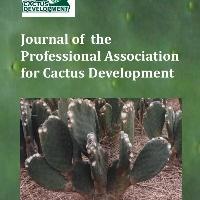Resumen
- To identify production and trends on publications of cactus pear from 1900 to 2015 at an international level, a review of qualitatively and quantitatively indexed bibliographic records from Science Citation Index Expanded (SCIE) and Social Sciences Citation Index (SCIE) was conducted. The analyses included the concepts or key words 'opuntia' as well as the common names of cactus pear and its variants. It was found that there were 1,472 documents regarding cactus pear, from which 50% were published during the last ten years, and more than 81% after 1990; these data show the relevance and dynamism of cactus pear research during the last years. The most indexed type of document was the article with 86.1%. The preferred language of publication was English with 92.7%. The Institutions with more indexed documents were the university system of the University of California and the National Autonomous University of Mexico with 99 (6.7%) and 84 (5.7%) respectively. The Journal of the Professional Association for Cactus Development (JPACD) had the highest number of scientific articles (92). The impact factor (IF) of JPACD is 0.22, and is ranked 30 among 33 in the "Horticulture" category of the Journal of Citation Reports (JCR). Plant Physiology the journal with the highest IF (6.28) published 29 of the indexed documents. The main research areas where scientists publish according to SCIE and SCCI are: Plant Sciences, Food Science Technology, Environmental Sciences, Horticulture, Ecology, Applied Chemistry, and Biochemistry and Molecular Biology. Mexico and the United States published 50% of all production, but Tunisia, Brazil, France and South Korea had an important number of contributions on Opuntia. The main native English authors speaking with more published documents in mainstream journals are Nobel and Felker, while Saenz and Murillo-Amador are the main native Spanish speaking authors. The trending research in the last ten years are the functional properties and biological activity of active ingredients on Opuntia. The identified trends would allow setting strategies, synergies and scientific and technologic policies for research and decision making in those countries where the species is considered as important.
